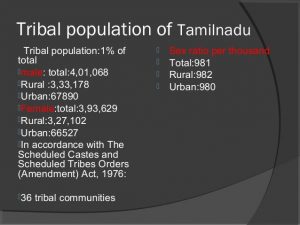The total population of Tamil Nadu, as per the 2001 Census is 62,405,679. Of this, 651,321 (1 per cent) are Scheduled Tribes (STs). Thirty six (36) STs have been notified in Tamil Nadu by the Scheduled Castes and Scheduled Tribes Order (Amendment) Act, 1976. Of the STs, six have been notified with area restriction. These are Malayali, Kurumbas, Kanikaran, Kammara, Kota and Toda. Malayali have been notified in Dharmapuri, Vellore, Tiruvannamalai, Pudukkottai, Salem, Namakkal, Villupuram, Cuddalore, Tiruchirappalli, Karur and Perambalur districts, Kurumbas in Nilgiri district, Kanikaran in Kanniyakumari district and Shencottah taluk of Tirunelveli district. Kammara, Kota and Toda have been notified through out the state except Kanniyakumari district and Shencottah taluk of Tirunelveli district.
The growth rate of ST population in the decade 1991-2001 at 13.4 per cent is higher than the overall growth rate of 11.7 per cent of the state. As per the 2001 Census, among the numerically large STs, Kurumans have reported the highest growth rate of 43 per cent, followed by Malayali (24.2 per cent), Irular (12.1 per cent) and Kattunayakan (5.8 per cent).
Of the STs, Malayali, Irular, Kattunayakan, Kurumans and Kondareddis together constitute 85.3 per cent of the ST population of the state. Malayali are the largest ST with a population of 310,042, constituting 47.6 per cent of the state ST population. They are followed by Irular, numbering 155,606 (23.9 per cent), Kattunayakan 45,227 (6.9 per cent), Kurumans 24,963 (3.8 per cent) and Kondareddis 19,653 (3 per cent). Fourteen (14) STs have returned population below one thousand in 2001 Census.
Expectedly STs are primarily residing in the rural areas and only 15.4 per cent are in the urban areas of the state. Among major STs, Malayali have the highest (98.3 per cent) rural population, followed by Irular (87 per cent), Kurumans (78.9 per cent) and Kondareddis (71.7 per cent). On the other hand, Kattunayakan, the third largest ST population have reported as much as 61.6 per cent urban population. Salem, Tiruvannamalai, Viluppuram, Vellore, Dharmapuri and Namakkal are major ST populated districts of the state as these six districts account for 64 per cent of the ST population of the state.
Sex Ratio
The overall sex ratio of the ST population in Tamil Nadu is 980 females per 1000 males, which has recorded improvement from 960 in 1991 Census. Among the district, Thanavur has recorded the highest sex ratio of the ST population (1054) and Perambalur the lowest (936).
The overall sex ratio of ST population in Tamil Nadu is almost equal to the sex ratio of ST population of the country. But in case of child sex ratio (0-6), it is less by 28 points than that of ST population aggregated at the national level. At the individual tribe level, all major STs, except Irular, have lower sex ratio in 0-6 age-group populations, as compared to the state ST population. Among these Kondareddis and Kurumans child sex ratio is alarmingly low.
Literacy and educational level
Literacy and level of education are two basic indicators of the level of development achieved by a group/society as literacy results in more awareness besides contributing to the overall improvement of health, hygiene and other social conditions. According to 2001 Census, percentage of ST literate (those who can read and write with understanding) persons aged 7 years and above is 41.5 per cent in the state, which is lower than 73.5 per cent reported for the state as a whole. The literacy rate (41.5 per cent) has however increased from 27.9 per cent recorded in 1991 Census.
Among the major STs, Kondareddis are reported to have the highest 78.2 per cent literacy rate, followed by Kurumans (61.4 per cent), Kattunayakan (54.7 per cent), Malayali (37.4 per cent) and Irular (34.3 per cent). The female literacy rate of 32.8 per cent among ST population is lower than 64.4 per cent registered among total female population of the state. As in literacy rate, the highest and lowest female literacy rate of 68.9 per cent and 27.1 per cent are also recorded among Kondareddis and Irular.
Out of the total literates, 36.6 per cent are either literates without any educational level or have attained below Primary level. The literates, who have attained education up to Primary and Middle levels, constitute 33.3 per cent and 14.7 per cent respectively. 12.8 per cent are having educational level up to Matric/Higher Secondary levels, implying that every 8th ST literate is a Matriculate. Literates with educational level of Graduation and above are 1.8 per cent. Individually, Kondareddis (8.3 per cent) have the highest percentage of Graduation and above educational level.
Religion
Majority of the ST population of the state are Hindus (99.2 per cent). There are only 3,497 (0.5 per cent) Christians and 453 (0.1 per cent) Muslims ST populations in the state.
TNPSC Notes brings Prelims and Mains programs for TNPSC Prelims and TNPSC Mains Exam preparation. Various Programs initiated by TNPSC Notes are as follows:-- TNPSC Mains Tests and Notes Program
- TNPSC Prelims Exam 2020- Test Series and Notes Program
- TNPSC Prelims and Mains Tests Series and Notes Program
- TNPSC Detailed Complete Prelims Notes